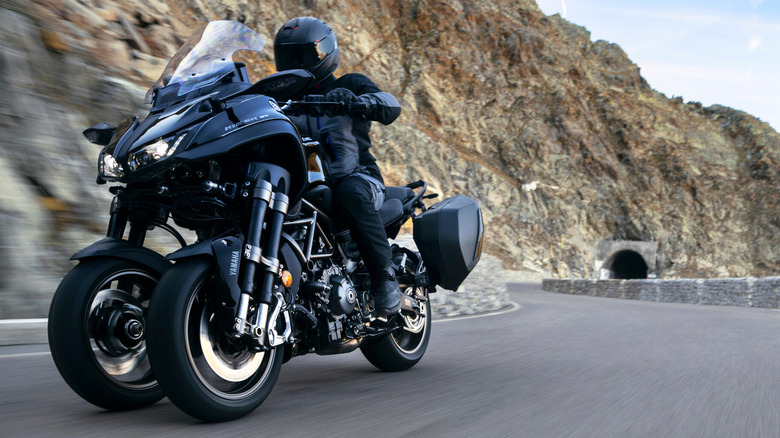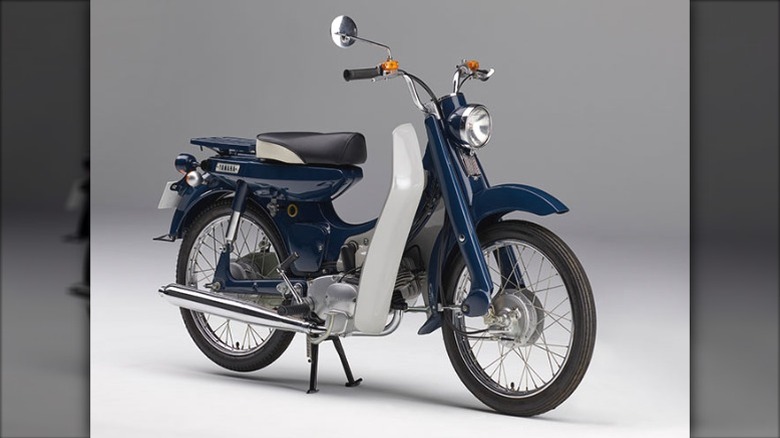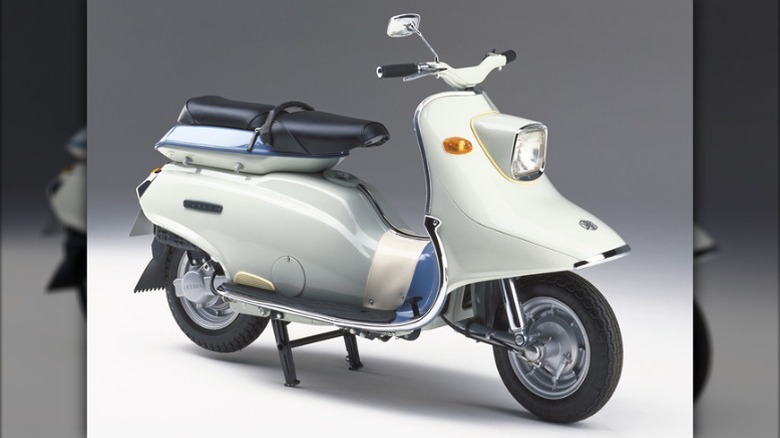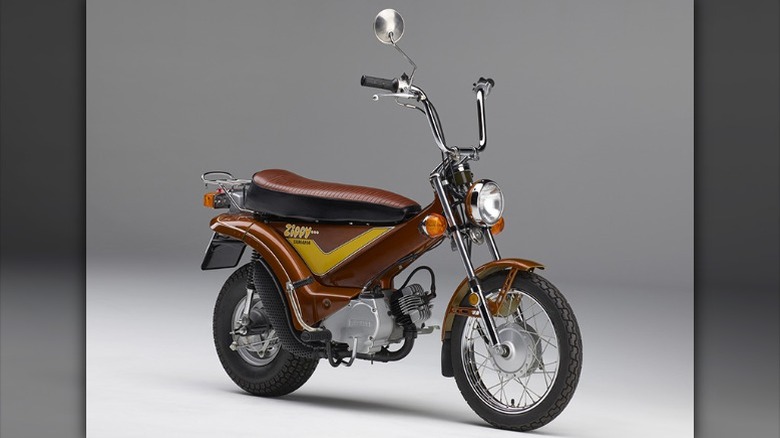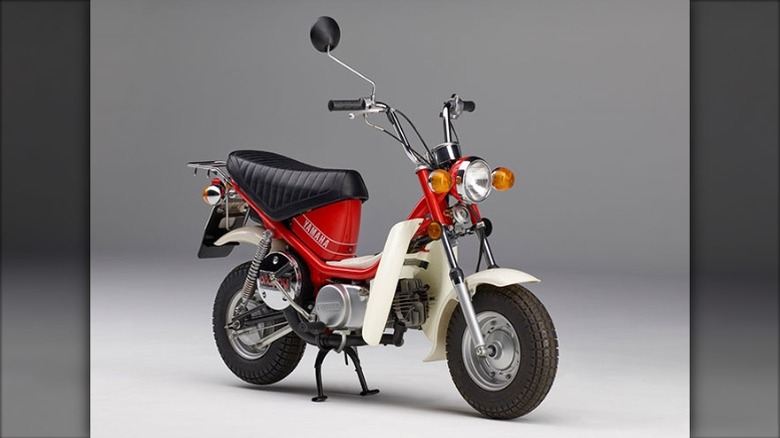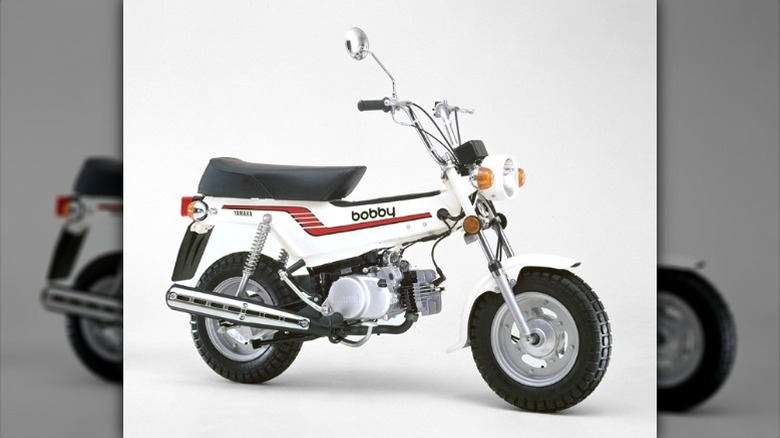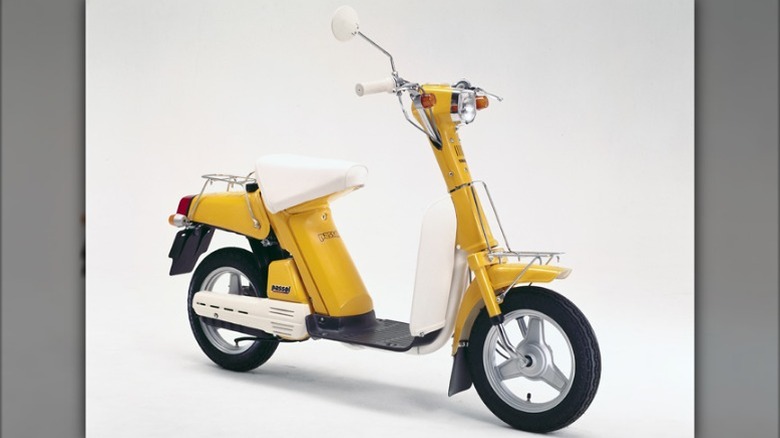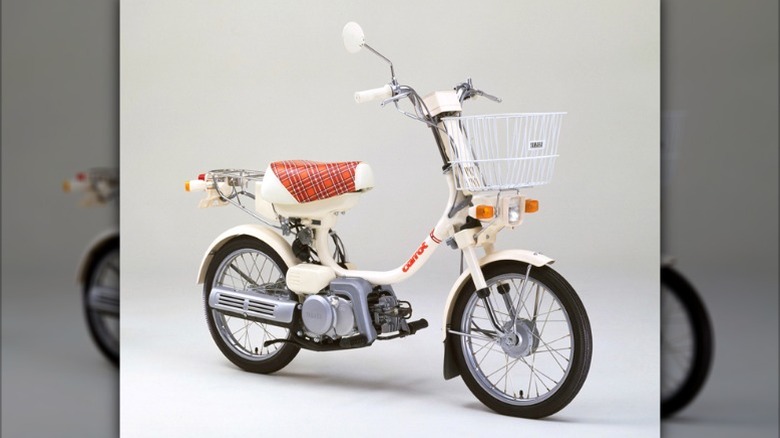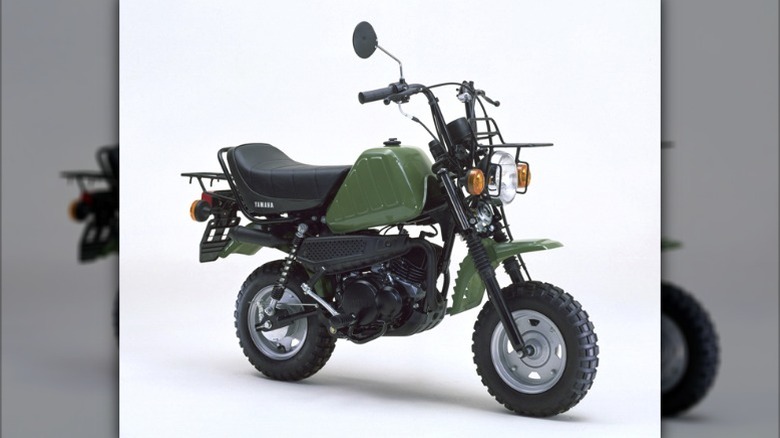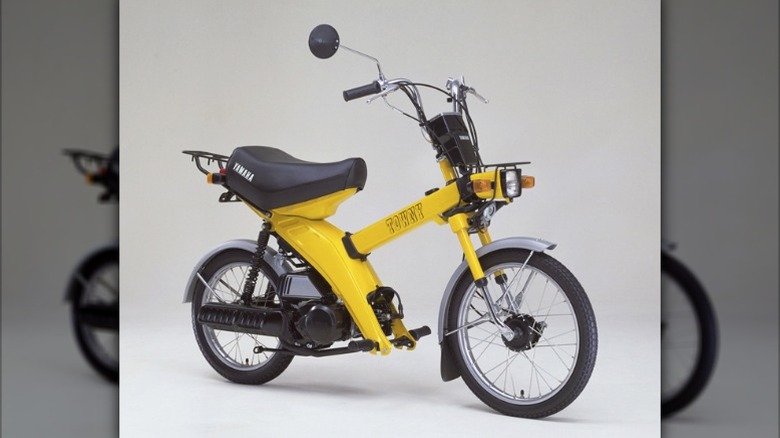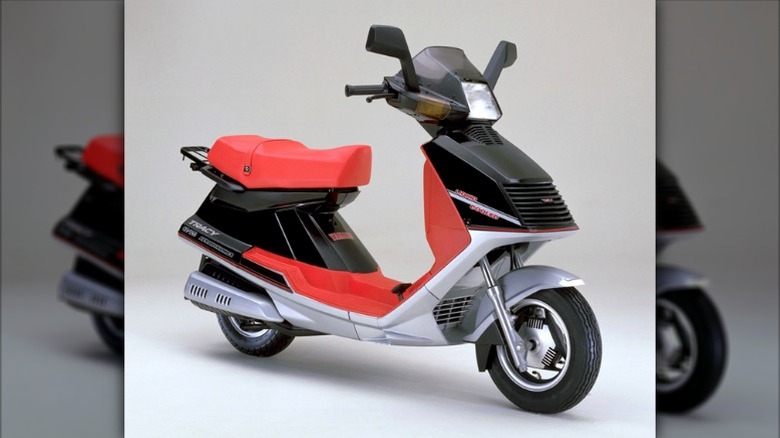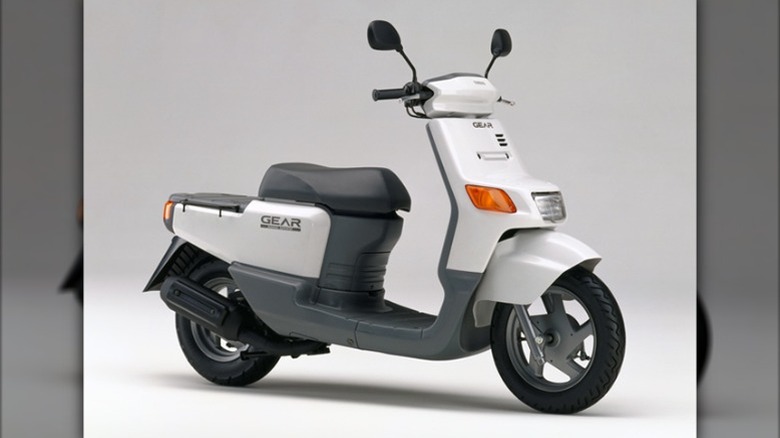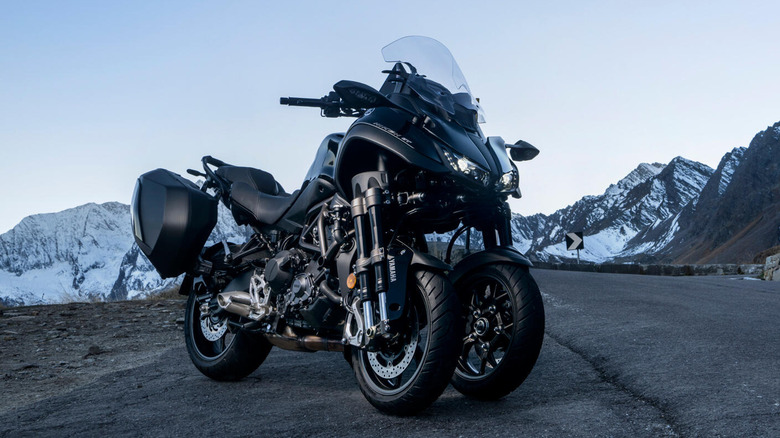12 Of The Strangest Yamaha Motorcycles Ever Made
Yamaha has been building motorcycles for over half a century. The company built its first-ever motorcycle, the YA-1, in 1955, the same year that Yamaha Motor Co. split from the original Yamaha Corporation. Since then, it has built a dizzying array of two-wheelers, including a handful of legendary bikes such as the YZF-R1 and MT-07.
We've covered Yamaha's iconic bikes many times over, but for as great as they are, there's more to motorcycles than high performance, excellent handling, or class-leading technology. For every YZF-R1 in Yamaha's back catalog, there's a quirky, out-there, and downright strange motorcycle, like the Vogel or Niken, to appreciate. And it's precisely those kinds of motorcycles that we're going to look at this time around.
We've whittled the selection down to 12 of the oddest bikes to carry the Yamaha Motor Co. badge, ranging from a blatant copy of a rival manufacturer's hit bike to a unique three-wheeler that may or may not be one of the most daring bikes from a major motorcycle manufacturer. Some of these may not be as out there as some of Honda's strangest motorcycles ever, but we think you'll agree that they're all notable departures from what we think of when the name Yamaha comes to mind — for better or worse.
Yamaha Mate
When you think of Yamaha motorcycles, you likely don't imagine the company building and releasing a direct copycat of a rival manufacturer's model. But that's precisely what the Mate — and its eventual successor, the TownMate — was: a faithful copy of Honda's iconic Super Cub.
The Super Cub debuted in 1958 and quickly became a best-seller in Japan and across the world. Honda sold 167,000 units in Japan in 1959 and made great inroads into the U.S. market, selling 1,000 units a month in 1961 and 40,000 units in 1962 — all with a puny 50cc engine. So it's not much of a surprise that Yamaha decided to follow in Honda's footsteps with its own simplistic underbone motorcycle.
The Mate U5 and U5D debuted in July 1965, powered by a 50cc two-stroke engine making 4.4 hp and 3.7 lb-ft of torque. Yamaha quickly followed these models up with the Mate U7, which had a larger 73cc engine, and continued to iterate on the Mate over the following decades. The V50, V70, and V90 versions came out in 1971, but the biggest update to the model would come in the following decade: 1981 saw Yamaha introduce the Town Mate with 50cc and 80cc four-stroke engines, both of which the company produced until the late 1990s.
Yamaha SC-1
The SC-1 was Yamaha's first scooter. Released in 1960, well after rivals like Mitsubishi had brought the scooter revolution spearheaded by Italian company Vespa to Japanese shores, the SC-1 adhered to the scooter template with the step-through construction but was quite a radical departure from the norm in other areas, not least the design.
The Vespa was all graceful lines and subtle elegance; the SC-1, not quite. Not to say that it was ugly, mind you: its combination of subtle boxiness, flowing bodywork, and an almost bird-like front beak has its charm, although it must have looked like something from the future in 1960. It may not have the retro charm of Vespa's scooters, but we think it's aged reasonably well despite that — although it still, admittedly, looks a bit odd even now.
Yamaha didn't just bolt a fancy body atop an old-school two-wheeler, though: The SC-1 featured some novel tech for the time, including an electric starter, a torque converter, a two-speed transmission, and single-sided suspension for the front and rear wheels. The engine was reasonably potent, too, with the 175cc two-stroke engine capable of 10.1 hp and 11 lb-ft of torque.
And before you write in: yes, we're aware that Vespas (and scooters) technically aren't motorcycles. But let's leave the strict definitions aside for today and enjoy the quirkiness of the SC-1 (and the other Yamaha scooters yet to come).
Yamaha Zippy
Yamaha's 1970s and 1980s scooters and mini-bikes may not be as legendary as '70s bikes like the XT500, but they're an almost endless wellspring of fun, quirky, and strange designs. Case in point: the Yamaha Zippy from 1973, a 50cc minibike that oozed pure 1970s glory, especially in brown — which is, of course, the color Yamaha has chosen to keep in its collection; whoever put that collection together certainly knows their stuff.
None of the Zippy's elements on their own come across as all that strange, but the total package definitely has an aura of the unconventional to it. Witness the thick backbone frame, very tall handlebars, long seat — apparently available in tartan, although we've not been able to corroborate this claim — and fat 5x8-inch rear tire. It's quite a combination, the latter especially standing out when compared to the front's wire wheel and thin rubber.
Mechanically, the Zippy had an automatic centrifugal clutch that helped deliver the 50cc engine's 4.4 hp and 3.8 lb-ft of torque to the rear wheel. So it wasn't a fast bike, then, even with its 163-pound weight, but that's not what riding a compact bike is about: As the best road-legal mini-bikes prove, there's more to life on two wheels than burning rubber and flaunting speed limits.
Yamaha Chappy
Like the Zippy, 1973's Yamaha Chappy was a mini-bike — in 50cc and 72cc variants — that had fun and character to spare. Developed, according to Yamaha, primarily for women, the Chappy had small 8-inch tires, a two-speed automatic — followed by three- and four-speed models later in the model's lifespan, as well as a 72cc model — and styling that looked something like a cross between the Mate and the Zippy.
The white plastic fairing has strong echoes of the Mate (and Super Cub, to be fair), but the taller handlebars and that rear tire is all Zippy. The seat is on the funky side, too, with its ribbed fabric that goes down all the way to the sides. The Chappy was a reasonably fast mini-bike according to those who've owned one, and the numbers back it up: the 50cc version made 3.5 hp and 4 lb-ft of torque, while the 72cc version made 4.4 hp and 4.7 lb-ft of torque. A lot of poke, then, especially considering the weight.
Now, it was never going to be a highway cruiser, but the Chappy's surprisingly torquey engines and low gearing probably made it quite a lot of fun in low-speed situations bombing around town and on easy trails, as seen in Yamaha's marketing. Perhaps not quite as off-road-ready as Yamaha's modern 50cc motorcycles, admittedly, but potentially good fun nonetheless.
Yamaha Bobby
The Yamaha Bobby came a few years after the Zippy and Chappy duo and, while perhaps a bit less quirky than both, is another worthy entry in this list of the strangest Yamaha motorcycles ever. Not that it was mechanically all that different, mind you, with 50cc or 80cc two stroke engines pushing its 160-pound weight along the highways and byways of '70s Japan, the former with 3.6 hp and 3.2 lb-ft of torque.
So far, so normal, then, as far as Yamaha's 50cc mini-bikes go. But the Bobby's design proved that while Yamaha wasn't necessarily pushing the envelope when it came to the mechanicals, its design ethos remained quite singular. This particular mini-bike's unique selling point was the frame, which packed the battery, air cleaner, fuel tank, and oil tank into the central backbone. It was an ungainly setup on paper, but Yamaha pulled it off with panache, going all-in with a thick backbone and some wonderfully late-1970s decals.
Other fine details included the small, thick wheels, perforated chrome exhaust cover, and tall handlebars. Not as strange as the Zippy and Chappy, perhaps, but still quite an outlier design-wise. Oh, and the name? Yamaha says it was intended to imply "bouncing around without a care." You do you, Yamaha.
Yamaha Passol
Building a motorcycle primarily for women may seem quaint — and possibly problematic — now, but Yamaha was all for it in the 1970s. The Chappy was one of the company's first attempts, but 1977's Passol took things even further with its pure step-through design that didn't require riders to put a leg over any bodywork. They could just step in, sit down, and be off.
The Passol is a strange one, with a design that has obvious echoes of the Mate and Super Cub, but with some genuinely eye-catching angles, especially at the rear. That combination of the seat's upward angle and all the slanted bodywork of the bike's back half looks weirdly avant-garde for what was supposed to be a mass-market two-wheeler, but we're not going to complain: it's a great look.
Other user-friendly features included an automatic clutch, hand-operated rear brakes, and an impressively light 100-pound weight. All the better, then, considering the 50cc two-stroke only made 2.2 hp and 2.6 lb-ft of torque. The company claims that the Passol was a hit, attracting a wide range of customers and launching a segment it called the "soft bike." Yamaha followed the Passol up with the similar-looking Passola in 1978, which tweaked the bodywork slightly, added creature comforts like a fuel gauge, and cranked up the power to a heady 2.7 hp.
Yamaha Carrot
We'll be honest: many of the Yamaha bikes on this list are here partly because of the names. Zippy, Chappy, and Bobby have all been great fun, but Carrot? We had to include it, even if it were a run-of-the-mill motorcycle. Thankfully, it isn't — you weren't expecting anything less from Yamaha, were you?
The Carrot came out in 1979, following hot on the heels of the Passol and Passola. It was another affordable two-wheeler designed for the soft bike market segment that Yamaha had created with its earlier offerings. It was even lighter than the Passol, coming in at just 92.5 pounds, with its 50cc two-stroke engine sharing the Passol's 2.2 hp and 2.6 lb-ft of torque. But the Carrot wasn't a step-through like the Passol: instead, it looked more like a motorized bicycle, with a pipe frame and bicycle-like handlebars — complete with hand-operated brakes and an optional front-mounted basket.
We're particularly fond of the version of the Carrot in off-white with a red plaid seat and can imagine many an example pottering through Japanese streets in the late 1970s and early 1980s.
Yamaha Vogel
If you read our list of the coolest-looking Yamaha ATVs, you'll know that we're fans of the Japanese company's off-road and utility ATVs of the 1980s and 1990s. There's something about their mix of chunky styling and occasionally over-designed bodywork that just works for us. The company's Vogel is probably the closest it ever came to reaching that same level in a bike, and what a bike it is.
Yamaha released the Vogel in 1980 as an outdoor-focused mini-bike, with blocky eight-inch tires and cargo shelves at the front and rear that Yamaha adorned in olive green, white, or orange, with black metalwork. The fuel tank is a particular highlight, with proportions that looked like someone squeezed it horizontally in Photoshop. The end result, combined with the shrunken proportions, makes the Vogel looks like a super-deformed take on a tough off-road motorcycle. Truly a sight to behold.
The Vogel came with a torque induction two-stroke 50cc engine with 2.9 hp and 3 lb-ft of torque. Yamaha also had a road-going version of the Vogel called the Pocke, which had a similar design but standard tires and no cargo carriers, so it's not nearly as cool in our book. Unless you're talking about the Midnight edition Pocke from 1981, that is, with its black and gold color scheme that's not dissimilar to the John Player Special livery that adorned one of the fastest F1 cars ever, the Lotus 78.
Yamaha Towny
The Passol was a hit according to Yamaha, and the Towny was a direct result of its success. A soft bike targeted at men, this was beefier — by the standards of the Passol, at least — with a more powerful 2.7 hp engine and a much thicker frame designed to suit taller and heavier riders. Did Yamaha need to target men specifically? Probably not, but let's not let questionable marketing take away from what is another charmingly quirky 1980s Yamaha offering.
Despite being a response to the Passol's success, the Towny, at least on a visual inspection, looks more like a follow-up to the Carrot than anything else. It has a similar motorized bicycle look complete with bicycle-style handlebars and hand brakes, just with a chunkier frame that reminds us of some modern electric bikes. We're thinking particularly of the Swagtron EB-7 here, which we named one of the best electric bikes from 2023.
As with many of Yamaha's scooters, the Towny had a shaft-driven drivetrain, which meant that riders wouldn't have to deal with potential muck flying off the chain and dirtying their clothes. The Towny was one of the three motorcycles to win a Japanese G Mark award in 1980, alongside Suzuki's FA50 and RG50E.
Yamaha Tracy
By 1983, naming scooters after vegetables, animals, and adjectives was probably old hat for Yamaha. A new decade required a new kind of name for its scooters, and that's precisely what we have here: the Yamaha Tracy. Who knows whether it's a reference to Dick Tracy or Tracy, California, but one thing's for sure: it's as perfectly Yamaha a name as you'll ever get.
There was more to the Tracy than just its odd name, though. For one, it was much more powerful than older Yamaha scooters, with a 123cc engine producing a healthy 15.8 hp and 12.3 lb-ft of torque. The engine wasn't just reasonably poky for a scooter, it was also allegedly quite fuel efficient thanks to the company's Yamaha energy induction system (YEIS), which accelerated the two-stroke engine's intake charge. This which had the knock-on effect of increasing efficiency and thus fuel economy.
The Tracy was also a great-looking scooter, at least if you're a fan of the 1980s. It's a retro-futuristic look, all angular lines and three-tone plastics, with a front grill that wouldn't have looked out of place on a contemporary car. Yamaha claims that the body wasn't just for show, either. It was also an allegedly aerodynamic shape, going along with the Tracy's focus on sportier riders. We'll leave you to figure out just how aerodynamic an upright scooter could ever be, though.
Yamaha Gear
On a list of very Japanese motorcycles, the Yamaha Gear may very well be the most Japanese of them all, but not because of a silly name, quirky design, or technological prowess. Simply put, the Gear is a bike built for deliveries in congested Japanese cities like Tokyo, with its network of tiny side streets too narrow for conventional four-wheeled vehicles.
To that end, the Gear has a shortened one-rider seat and a large shelf behind the rider complete with strap-down hooks, perfect for stacking boxes and other items for delivery. Powering mid-1990s Japanese delivery riders on their routes was a 50cc two-stroke engine that made 4.9 hp and 4.1 lb-ft of torque. Nothing exciting, even for a scooter, but that wasn't the point: Urban delivery riders needed good low- and mid-range torque and great fuel efficiency, and that's exactly what Yamaha focused on with the Gear's engine.
The Gear is otherwise a pretty staid motorcycle, with unobtrusive looks in a gray-and-black finish, and thus it's not nearly as visually striking as other Yamahas on our list. But it's all about that rear shelf, and the odd notion of a motorcycle built to carry goods and cargo ong before same-day delivery services dominated the world.
Yamaha Niken
So far, all the motorcycles on this list have been fundamentally conventional two-wheelers, but not Yamaha's Niken. This isn't just any three-wheeler, either: it has two front wheels, as opposed to two rear wheels like Honda's old three-wheel ATCs.
The Niken, which debuted in 2019, has what Yamaha calls a leaning multi-wheel (LMW) chassis, which in Yamaha's words provides "unparalleled rider confidence across a wide range of road conditions." The extra front wheel offers more grip and stability, especially in corners, without overly affecting the traditional two-wheeled riding experience. Reviewers of the time managed to push the Niken to 43 degrees of lean in corners without breaking a sweat, with the dual front wheels inviting confidence no matter the weather conditions.
It also had quite a bit of power to complement the fancy chassis tech, with a three-cylinder, 847cc engine derived from the CP3 motor in the Yamaha MT-09. Yamaha updated the Niken with better suspension, a more powerful engine, and improved rider ergonomics for 2023, but the bike may not be long for this world: the model was no longer available in North America by the time the refreshed model debuted, while Japanese sales ceased in April 2024.
